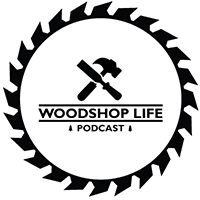Brians Questions:
Hi again guys, And thank you for contiuing to make THE BEST woodworking podcast. I have an 8″ benchtop style crappy planer(jointer) thicknesser combo machine. The cheap ones you find in lots of colors. It has straight blades and quite short in and outfeed tables. I also have an Axminster AT330ST thicknesser, large lunchbox style, 330mm capacity with a spiral cutter head. I generally do my edge jointing on the table saw with a sled. First of all. When do you choose to skip plane instead face jointing the board first? And second: Would you do it differently with my setup. Thanks again, Gøran Eliassen Nomad Makes
Love the podcast, I have a small unheated shop in Northern Canada. I’ve learned that during the winter months I need to bring in all my glues and finishes as they don’t respond well to freezing. I also learned the hard way that my warm glue on frozen wood doesn’t work either. My question is, how long should the glue set before I can return it to freezing conditions? I usually try for 24 hours but this can create long delays in projects and fills my house with glue up panels. Also is there a type of glue that would work best in freezing conditions. CA glue works fine, but isn’t strong enough for panel glue ups or assembly. – Ben
Thought this might be a fun question. If you aren’t familiar with the phrase “the cobbler’s children have no shoes,” it often means that you are taking care of other’s needs before your own. But it can also be used to mean something that everyone expects of you in your field/craft that you have never done. For example, I always hear that everyone’s first project is a cutting board, but I was in the craft for years before I made one! And I’ve yet to cut a mortise and tenon! So, what haven’t you made that everyone would think you had, or what skill do you not have that it would be assumed you do? Peter Downing @mr.downing.woodworking on Instagram
Huy’s Questions:
Hey guys! I appreciate your podcast and always look forward on listening to the latest episodes! I am a hobby woodworker who has done some commission builds. As my hobby is turning into a side hustle more and more I am wondering at what point do I make it “official”. I live in the Nashville, TN area and there is a strong market for custom woodworking. Whilst I don’t “need” the money, the thought of fueling my hobby and having the extra cash seems viable. Have any of you became an LLC or setup a DBA? Are there benefits on doing so even if my business would stay relatively small? Again, love the podcast and thank you for your contribution to the community! God Bless! -Will
Great podcast! I am looking for your opinions on a good set of brad point drill bits that won’t break the bank. I’ve been using a set from Harbor Freight, and I would like to step up in quality. I’m a hobbyist who doesn’t need the best, just decent quality. Any ideas? -Dan
I think that my next tool purchase might be for a tracksaw-like guide for a circular saw or something similar. We sometimes run into situations where we need to rip a straight line. This would actually be more for ‘carpentry’ applications than fine ‘woodworking’. Things like ripping a long 2×6 or 2×8 at an angle, or rip a sheet of plywood in the field (so portability and reasonable durability would be important). Whatever we buy would be used by a lot of different guys and we’d keep it in our shared workshop. Most of the guys have Dewalt circular saws but several guys have other brands (Milwaukee, Ridgid, etc.). So the track would have to be adjustable for the bases of the various saws. I’ve spent zero time investigating this. Thought I’d start here. Any recommendations? – Mark
